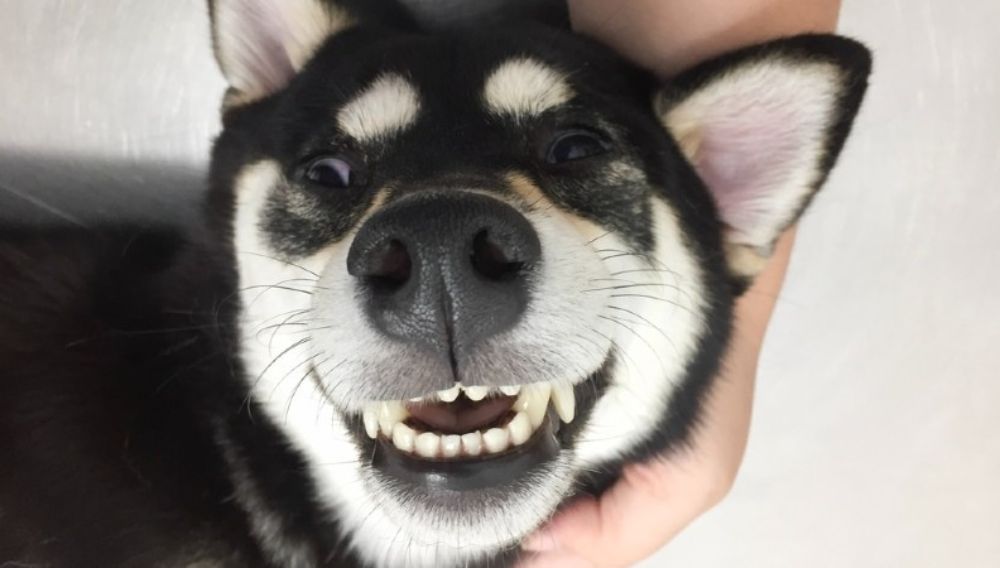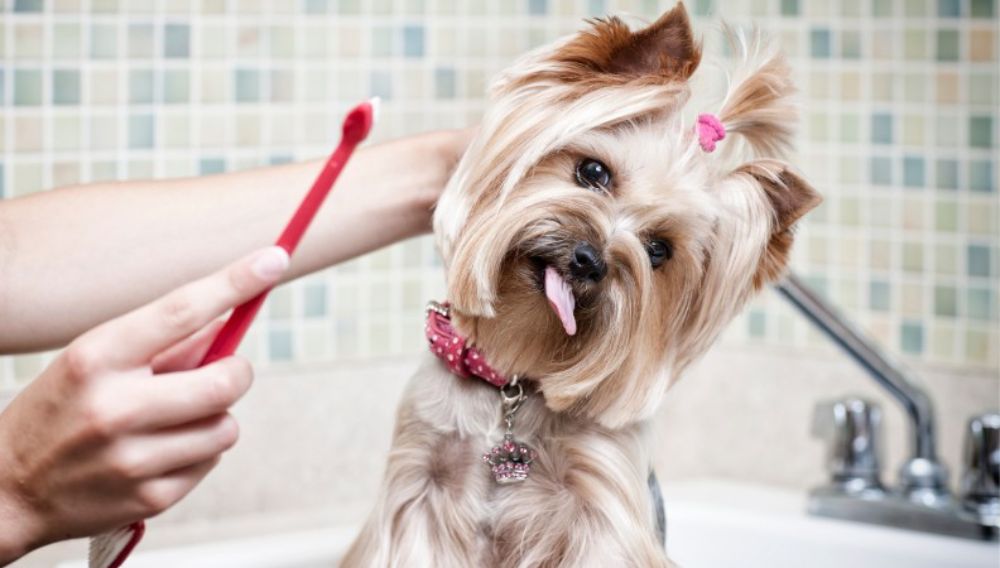The cleaner the teeth, the sweeter the greeting: the first thing you notice when your best buddy jumps up to say hello! And as if banishing dog breath wasn’t motivation enough, there are loads of other health reasons to keep those gnashers in tip-top condition.
Watch Everypaw’s very own vet Anna demonstrating the easy way to check and clean your dog’s teeth.
Why You Need to Keep Up with Your Dog's Dental Care
A crowded mouth, too much plaque, gum disease, ulcers and abscesses, cavities, chips and breakages… virtually all of the dental disasters that humans have to deal with from time to time can affect our canine friends, too. Check-ups, a scale and polish, dental radiographs, anaesthetics, extractions, root canal treatment – the costs of these can mount up and are best avoided!
Thanks to better diets and medical treatment, our furry friends can now live well into their teens. But those extra years of chewing and chomping mean a lot more scope for dental wear and tear. Here’s why you should keep on top of it...
Your Dog Can't Tell You They've Got a Toothache
The only way you’re going to find out if there’s a chip, a sore gum or anything else in need of attention, is to get in there and have a look. Dogs will instinctively hide any discomfort if they can - so by the time they show physical pain, the problem’s likely already pretty advanced.
Take Proper Care Before it's Serious
In terms of consultations, repair work, medication and follow-ups, a bad case of infection can be complicated (and expensive!) to treat. Prevention - i.e. good dental hygiene - definitely pays off, as does treating problems quickly before they grow into something serious.
Dog Teething Troubles
Just like us, dogs have a set of infant (deciduous) puppy teeth before their adult teeth come through at about 6 or 7 months. Sometimes these teeth don’t fall out as they’re supposed to and can cause overcrowding, weakened teeth, tooth decay and loss. As a rule, baby teeth that are still present at 7 months should be pulled out by the vet.

How to Spot a Problem
A healthy dog mouth looks a lot like a healthy human mouth. If everything’s in order, here’s what you should find…
- The teeth are white. Eating causes a sticky plaque (a yellow-white mixture of bacteria and debris) to form on the teeth - and if left, this will harden into tartar (calculus) which is a yellow-brown colour. Over time, this can cause the gums to pull away from the teeth, leading to possible infection and sometimes even tooth loss. So watch out for cream or brown staining which are signs of plaque and tartar build-up.
- No signs of trauma. When you take a look inside your buddy’s mouth, check for broken, cracked or worn teeth.
- Healthy, light pink gums. Red lines, bleeding, bumps, growths and gum recession around the base of the teeth are all signs of gum disease. Left too long, this can lead to loose teeth, infection and sometimes even damage to the jawbone.
- No bad breath. Here’s the thing: dog breath just isn’t normal - even if you happen to be a dog. Halitosis can be down to any one of a number of causes, but the most common culprit is a high bacterial count in the mouth.
Dog Dental Care: The Easy Way
If you’re doing it right, proper dental hygiene should become an important part of your dog’s life; something that’s as much a part of their routine as their daily walk. Introducing an element of reward and playtime, you can build a positive association around it. In your buddy’s mind, teeth brushing could be something to look forward to.
Stick to the Right Diet
A good quality feed should help slow down the formation of plaque and tartar. There’s nothing wrong with the occasional edible treat - but just stick to dog-specific treats that are formulated to help keep canine teeth healthy. Your vet can recommend special food for dental care and treats that are good for their teeth.
Stock Up On Quality Dog Chew Toys
Why do dogs love chewing so much? As well as having a calming effect, having something to gnaw on can help clear away soft tartar and massage the gums. So a decent supply of vet-approved chew toys can help make teeth cleaning easier. Hard chews such as antlers, hooves, cooked bones are not recommended as these can splinter.
Have the Right Tools to Brush Your Dog's Teeth
Do not use human toothpaste! Fluoride in high amounts is toxic to dogs - you need a specially formulated dog toothpaste. There are enzymatic varieties to help reduce plaque, and tasty flavours such as beef, seafood and poultry as well as mint for that fresh breath smell!
As for the brush, it should be easy for you to move it around and make it possible for you to access all areas of your buddy’s mouth. It might mean experimenting with small finger brushes and longer-handled versions to see what works best for you and your dog.

How to Clean Your Dog's Teeth
Ideally, you’ll be brushing your dog’s teeth once a day. But two to three times a week is better than not at all. If they’re just not into it, brushing is going to be a struggle - so choose a time when they’re most likely to be pretty relaxed. Right after a walk is a good idea.
For puppies and adopted dogs not used to brushing, ease them in slowly. In the early days, it’s ok if the brushing sessions are very quick; your aim is to get your dog used to the process. You can start with just rubbing their teeth with your finger covered by a soft cloth before moving on to a dog toothbrush and then using doggy toothpaste.
As they get more comfortable with it, there’s more scope to be able to do a proper job; accessing the back and front of all teeth - as well as cleaning the gum line. This will help to remove plaque and prevent periodontal disease developing that can lead to receding gums and tooth loss. Periodontal disease affects the area around the teeth and is very common, especially in older pets.
Brushing your dog’s teeth will involve patience and perseverance before your pet will accept the routine. You should brush their teeth at least 3 times a week will reduce the risk of advanced dental disease developing. Introduce tooth brushing slowly and follow these tips:
- To start with a soft cloth can be used to wipe the teeth, front and back. Do this twice daily and after about two weeks your dog should be accustomed to the procedure.
- Then using a dog’s toothbrush, soak the toothbrush in warm water and start brushing twice daily for several days, only adding the toothpaste once your pet accepts the brushing.
- The toothpaste should be placed between the bristles rather than on top - this allows the paste to spend the maximum possible time next to the teeth. Place the toothbrush bristles at the gum edge where the teeth and gum meet and then move the brush in an oval pattern. The bristle ends should go into the area around the base of each tooth and into the space between the teeth. Complete ten short back-and-forth motions, covering three to four teeth at a time. Pay most attention to the outside of the upper teeth.
Make Sure Your Dog has Regular Check-Ups
Your dog’s teeth should be checked by a professional once or twice a year - although this doesn’t necessarily demand a special trip to the vet dentist. If your dog undergoes a routine health check-up at the veterinary surgery once every six to twelve months, a dental exam should be included.
Keeping on top of all of this is part of ensuring your dog enjoys a happy, healthy, and toothache-free life.
Everypaw Dog Insurance
Everypaw's Dog Insurance comes with 24/7 unlimited access to vets and vet nurses that can help with your pet's health, care, nutrition and behaviour. So you can rest assured your pup will be well looked after.
If you take out an Everypaw Dog Insurance policy, dental cover is included in your vet fee cover. You just need to make sure you look after your pup's teeth, take them for regular check-ups and make sure you follow your vet's advice.